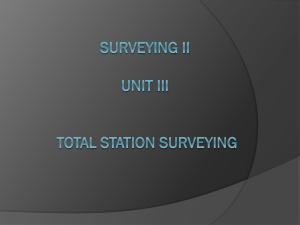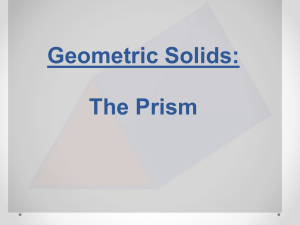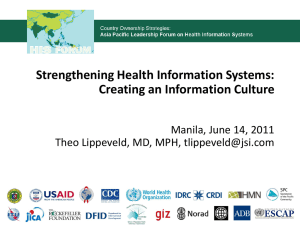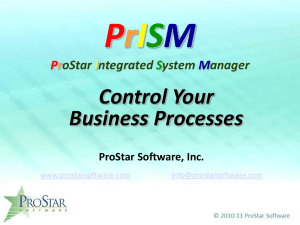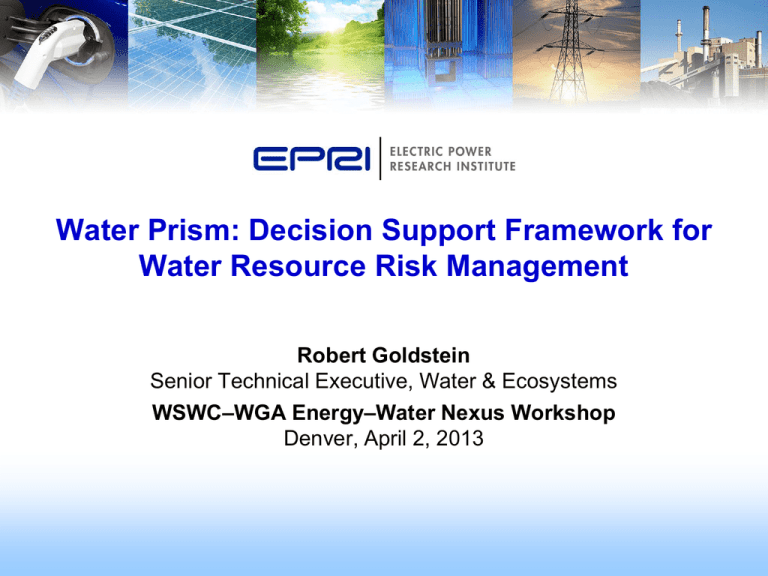
Water Prism: Decision Support Framework for
Water Resource Risk Management
Robert Goldstein
Senior Technical Executive, Water & Ecosystems
WSWC–WGA Energy–Water Nexus Workshop
Denver, April 2, 2013
Approaches to Reaching Sustainability
• Top down
– Community/region/watersh
ed-based
– Considers all stakeholder
demands
– Matches aggregate water
demands to supply
• Bottom up
– Sector/Facility-based
– Objectives
• Increase water use
efficiency
• Conservation
© 2013 Electric Power Research Institute, Inc. All rights reserved.
2
Drivers for Development of Water Prism
• Electric power generators reliance on
water resources
• Manage environmental, regulatory,
reputational, and financial risks
• Water stewardship disclosure requests
• Water saving technologies are
emerging for all sectors
• A need for tools to evaluate strategies
across sectors:
– Accommodate future demands
within limits of available water
– Encourage collaborative water
planning
• Roadmap for sustainability is difficult to
define given system complexities
Evaluate benefits of water resource management strategies and technologies
© 2013 Electric Power Research Institute, Inc. All rights reserved.
3
Water Prism Conceptual Design
• Compute system water
balance on regional scale
– Surficial watershed model
– Groundwater sources
and uses
• Project consumptive and
withdrawal demands for 40 to 50
year horizon
• Explore water saving
strategies through scenario
analysis
Water Prism Volume 1: Tool Development
(EPRI 1023771)
© 2013 Electric Power Research Institute, Inc. All rights reserved.
4
Examine various
scenarios to consider
water use reductions
needed to keep
“demand” below
“supply”
Water Prism Design Overview
Population, Energy Demand,
Irrigated Land use
Land use, Climate,
Topography, etc.
Water Prism Access Database
Watershed Model
Available
Surface Water
Water Prism DSS
Groundwater
Storage
Ground Water
Data
© 2013 Electric Power Research Institute, Inc. All rights reserved.
5
Four Basic Steps of a Water Prism Analysis
Define Available
Surface Water
Define Available
Groundwater
(calibrate watershed
model)
(map and parameterize
major aquifers)
Major
Water Prism
Steps
Add Water User Inputs
1. Calculate regional water
balance
Review System Water
Balance
2. Compare projected water
demand with available water
Build Water Prism
Scenarios
Display Water Prism
Results
© 2013 Electric Power Research Institute, Inc. All rights reserved.
6
3. Generate scenarios with
water saving strategies
4. Display reduced water
consumption and/or withdrawal
as a Water Prism spectrum
Preliminary Water Prism Applications
1. Muskingum
River Watershed
2. Green River
Watershed
• Goal – demonstrate tool functionality
• Leverage watershed modeling from EPRI’s Water Quality Trading
Project
• Promote synergies between projects
© 2013 Electric Power Research Institute, Inc. All rights reserved.
7
Muskingum Watershed Background
• Area: ~8,000 mi2
– Spans 5 counties and sections
of 22 others
– Several cities
– Largely agriculture
• Water Use:
– 174 surface water withdrawals
– 329 groundwater withdrawals
– 319 point sources
• Power Plants:
– 2 large coal-fired –
primarily once-through cooling
– 2 small coal-fired
– 3 NGCC (1 going online 2012)
closed cycle cooling
© 2013 Electric Power Research Institute, Inc. All rights reserved.
8
Muskingum River Power Plants
Power Plants in the Muskingum River Basin
Plant
Type
Owner
Capacity
(MW)
Conesville
Coal-fired
AEP
1745
Muskingum
Coal-fired
AEP
1425
Waterford
Natural Gas (CC)
AEP
Dresden*
Natural Gas (CC)
Washington Natural Gas (CC)
Dover
Orrville
Coal-fired,
Natural Gas
Coal-fired
Cooling Technology
Water Source
once-through(1 unit)/
closed cycle (3 units)
once-through (4 units)/
closed cycle (1 unit)
Muskingum River,
some groundwater
Muskingum River,
some groundwater
917
closed cycle
surface water
AEP
580
closed cycle
surface water
Duke
620
closed cycle
surface water
36.5
once-through (1 unit),
closed cycle (2 units)
surface water, some
groundwater
closed cycle
wastewater effluent,
some municipal and
groundwater
City of
Dover, OH
Orrville
Dept. of
Public
Utilities
84.5
* Under construction; expected to go on line in 2012
© 2013 Electric Power Research Institute, Inc. All rights reserved.
9
Input Data Sets for WARMF and Water Prism
Required Data Sets
Watershed
Model
(WARMF)
Water
Prism
DSS
Data
Source
Time
Period
Frequency
Topography (DEM)
USGS
NED
2009
30 meter
Land use / land cover
NLCD
2006
N.A.
Climate
NCDC
1990-2009
Daily
Observed streamflow
USGS
1990-2009
Daily
Groundwater properties (aquifers,
recharge)
USGS
N.A.
N.A.
Ecological flow / reservoir limits
?
?
?
Water withdrawals
ODNR
1990-2009
Monthly
Water discharges
OEPA
1990-2009
Daily
Projected demands (electric power)
AEP
Through
2014
N.A.
Projected demands (other sectors)
Dziegielewski
et. al, 2004
2005-2025
5-Year
© 2013 Electric Power Research Institute, Inc. All rights reserved.
10
Land Use / Land Cover (2006 NLCD)
© 2013 Electric Power Research Institute, Inc. All rights reserved.
11
Principal Aquifers
4 Principal
Aquifers
• 389 to 3741 mi2
Unconsolidated
• Shallow, follows
river valleys, high
porosity, high yield
Bedrock
• Deeper, low
porosity, low yield
© 2013 Electric Power Research Institute, Inc. All rights reserved.
12
Withdrawals and Returns
Surface water withdrawals
• 174 facilities
• 789 MGD (2009)
Groundwater withdrawals
• 329 facilities
• 131 MGD (2009)
Point source discharges
• 319 stations at 307 facilities
• 915 MGD (2009)
© 2013 Electric Power Research Institute, Inc. All rights reserved.
13
Development of Water Prism Strategies
• Planned power plant changes
– Retiring once-through coal units
– Conversion of coal to natural gas combined-cycle (NGCC)
– New NGCC plant on-line
• Reduction in municipal and industrial
– BAU: State of Ohio projects increased water use due to increased
population, increased per capita use and growth in industrial sector
– Prism Strategy: Assume decreased per capita use
• Reduce withdrawals and returns for municipal and industrial users
• 8% to 25% reduction over 60 year period
© 2013 Electric Power Research Institute, Inc. All rights reserved.
14
Water Prism Scenario: Reduced Per Capita Use
Surface Water – Small Tributary
Reduced Consumptive Demand for
Each Sector
© 2013 Electric Power Research Institute, Inc. All rights reserved.
Savings from Each Sector
15
Water Prism Illustrates Impact of
Decommissioning and Gas Conversion
© 2013 Electric Power Research Institute, Inc. All rights reserved.
16
Concluding Thoughts
• There is no such thing as Business
as Usual - everything is evolving with
time
• Everything is geographically
distributed non-uniformly
• Top down management is necessary
for sustainability
• Need localized, fine resolution
decision support tool to manage
community (watershed, region)
water resources
• Strategic and technological
approaches depend on location
• Research can lead to promising
breakthrough technologies to save
water
© 2013 Electric Power Research Institute, Inc. All rights reserved.
17



